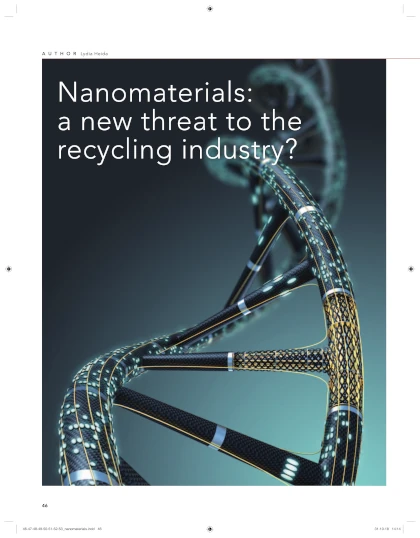Nanomaterials: a new threat to the recycling industry?
A large variety of nanomaterials is used in consumer products and industrial applications, and many of these products have reached the end of their life. However, studies have shown that various types of nanomaterials cause toxic effects, which makes the development of appropriate recycling strategies imperative.
‘Every 18 months, we see a doubling in consumer products that claim to contain nanomaterials in Europe,’ says Steffen Foss Hansen, associate professor at the Technical University of Denmark and co-founder of The Nanodatabase, which was set up in 2012.
Carbon nanotubes are used in electronics, batteries, sporting goods, composite plastics, concrete and ceramics. Nano-titanium dioxide is used in an equally varied amount of products: paints, coatings, building materials, textiles, electronics and metals, whereas nano-silver is mostly used in textiles, kitchenware and coatings.

Lack of information
The global nanomaterials market is expected to exceed US$ 55 billion by 2022 from US$ 14.7 billion in 2015, according to a report of Allied Market Research. The largest application for nanotechnology is electronics, followed by energy applications.
Many of these materials and products have already reached their end of life.
So the development of appropriate waste management strategies is critical, according to a report of the Organisation for Economic Co-operation and Development (OECD) about waste containing nanomaterials, that was published in 2016.
This is especially important since more than 11 million tonnes of nanomaterials are entering the market a year.
But this number is a rough estimate according to several experts.
‘There is a lack of access to information about how much nanomaterials are produced, how much is used, by whom, and wherein,’ explains Hansen. ‘We have been calling for regulation for a long time in this area, as any kind of risk assessment starts with knowing what is out there.’
Serious risks
Most nanomaterials are based on metals that are shrunken to a molecular scale: one nanometer is one billionth of a meter, which is 10 000 times smaller than the diameter of a human hair. At this scale, the material is no longer seen as a metal, but as a chemical that may have novel properties compared to their bulk form.
That is also the reason why nanomaterials have become so popular to use. Wind turbine blades with a coating that contains carbon nanotubes produce 30% more wind power than conventional blades. Nano-silver acts as an anti-bacterial agent in textiles, but this function makes these particles also deadly to micro-organisms in the soil.
Studies have shown that various types of nanomaterials cause toxic effects not induced by their chemically similar but larger particles, such as inflammation or fibrosis of the lungs or cancer as an analogy of the carcinogenicity of asbestos.
Other adverse health effects: interfering with the ability to reproduce, toxic effects on the liver, kidney and nervous system, cell death, chromosomal aberrations and DNA damage.
Penetrating body parts
‘Nanomaterials tend to be much more reactive, because they have much more surface area per unit volume than larger particles,’ explains Kai Savolainen, research professor at the Finnish Institute of Occupational Health and the coordinator of Nanosolutions, a project that was created to develop a safety classification for nanomaterials, to which 500 scientists contributed worldwide.
Also, the extremely small size of nanomaterials makes it possible that they penetrate parts of the body that are not reachable by their larger counterparts, such as the alveoli in the lungs. Nanomaterials can transfer through the lymphatics and blood into internal organs, and are able to pass the blood-brain barrier.
Some nanomaterials surface often in toxicity studies, such as carbon nanotubes, nano-silver, nano-copper oxide, nano-cobalt, nano-cadmium and nano-titanium dioxide. But experts agree that much more research is needed about the effects of nanomaterials on human health and the environment. (...)
Publication: Recycling International
Date: November 2018
Would you like to read the entire article? If so, please let me know!
CONTACT MEScarce, and getting scarcer
Read More

Boom time for carbon fibre recycling

Investing in the future of urban mining
Interested in working together?
I'd love to hear from you.